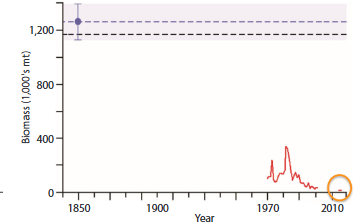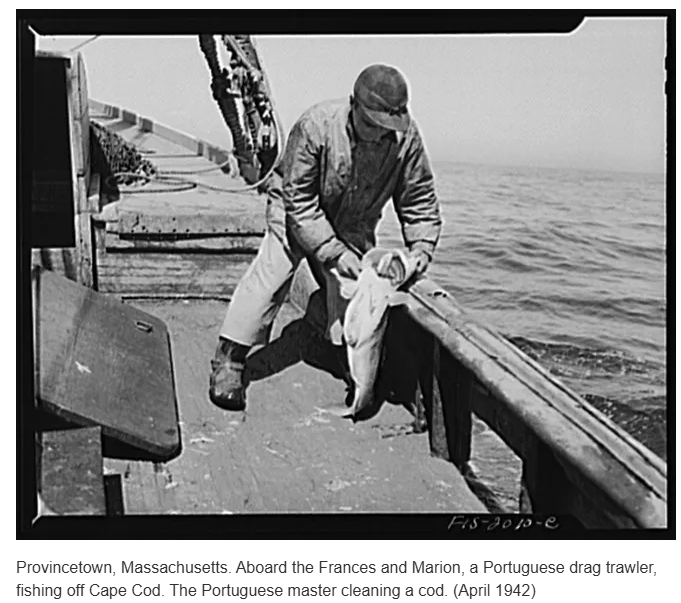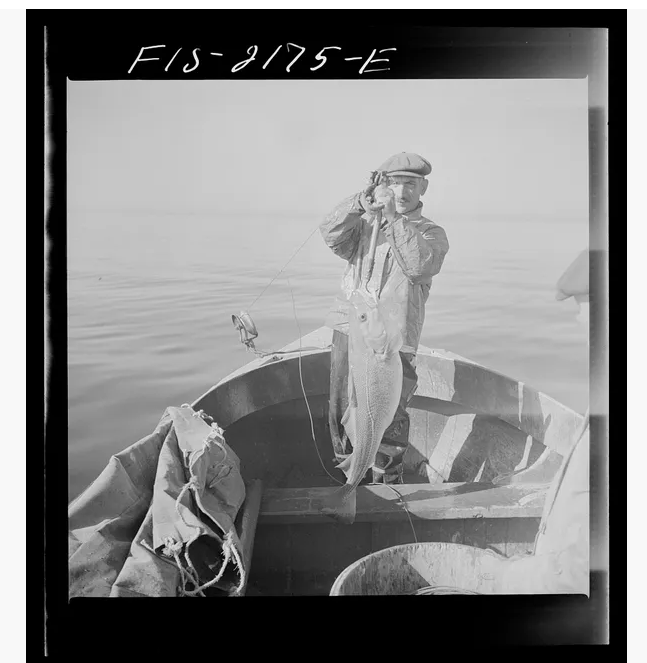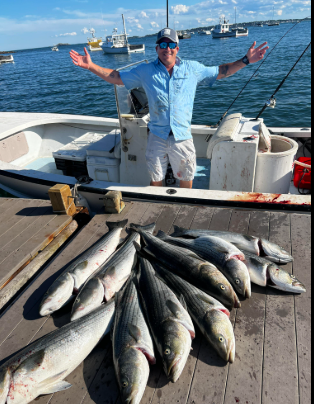Mismanagement of the Cape Cod Fishery
The mismanagement of fisheries reflects a failure to maintain ecological sustainability.

Bolster, Graph of marine populations, 2018

Bolster, Graph of cod biomass, 2018
Historic population crashes in fisheries, such as those of cod and striped bass in the 1980s, highlight the consequences of overfishing and inadequate management, leading to severe declines that took decades to recover from.
Cod biomass on the Nova Scotian Shelf in 1852 was estimated at 1.26 million metric tons. by 2002 cod biomass was estimated less than 50,000 metric tons By 2009, this dropped to 24,000 metric tons. (Bolster)
The decrease shows the long-term impact of overfishing which has led to an unsustainable population. As a result, restoration goals fail. This evidence supports the need for management practices that consider historical data to set historically informed targets for fishery restoration and sustainability.
When the moratorium on striped bass was enacted, the striped bass population had plummeted. Catches had plummeted from 14.7 million pounds in 1973 to 3.7 million in 1979. No improvement was shown until after the moratorium and even then it took years. (Baker)
The delayed implementation of the moratorium underscores how fishery management comes too late to prevent decline. By the time the moratorium was enforced, the striped bass population was already in a crisis. This shows that by the time regulations are put in place, the damage may already be done.
Historic Managment Issues

Historic photos: Cape Cod pics from the National Archives

Historic photos: Cape Cod pics from the National Archives , Man holding fish in an old wooden boat, 1942
In the present day, striped bass management underscores ongoing challenges in balancing conservation efforts with fishing pressures to maintain stable populations along the Atlantic coast.
In the 2021 striped bass assessment, it was found that the stock was overfished, with the female spawning stock biomass (SSB) estimated at 64,805 metric tons, which is below the updated SSB threshold of 85,457 metric tons and the SSB target of 106,820 metric tons (Celestino, 2021).
The fact that the striped bass stock remains overfished shows that the existing management strategies were insufficient in preventing stock depletion. It emphasizes the difficulty of balancing industry needs with long-term ecological sustainability and the complexity of implementing successful management practices.
After a near collapse of the striped bass in the 1980s moratoriums and catch limits were created. Despite this initial success, it was reported that striped bass populations had dropped below the threshold for sustainable levels. (ASMFC, 2018).
This shows that despite efforts, ineffective management has once again put the striped bass at risk. The slow response to declining population trends reveals a critical gap in how fisheries are managed. Inefficant enforcement allowed fish populations to drop to unsustainable levels before meaningful action was taken.

Getty Images, Man with multiple dead striped bass on a dock, 2017
Tuna management has long faced challenges of overfishing, ineffective regulations leading to severe threats to the spieces.
According to the International Commission for the Conservation of Atlantic Tunas (ICCAT), bluefin tuna stocks were reduced to 15% of their original size by the early 2000s due to over harvesting, despite conservation efforts from decades earlier. (Safina)
The decline in tuna populations illustrates the mismanagement, where regulations and enforcement often fail to do what is needed. This mismanagement jeopardizes tuna populations and threatens the stability of ecosystems that depend on this species, highlighting the critical need for better regulation and managment.
In 2010, ICCAT introduced stricter quotas and seasonal limits for Atlantic bluefin tuna to mitigate overfishing. The World Wildlife Fund (WWF) found that one-third of bluefin tuna caught in the Mediterranean were illegally harvested. (Safina)
The illegal fishing of bluefin tuna reveals the lack of effective enforcement. Although quotas are in place, they can often be ignored. This mismanagement demonstrates that regulations alone are insufficient without enforcement. This case emphasizes the importance of implementing enforced regualtion to protect tuna.

Getty Images, man holding a tuna, 2015